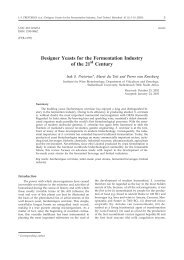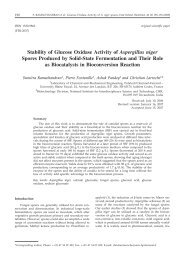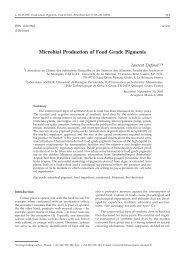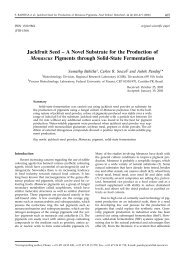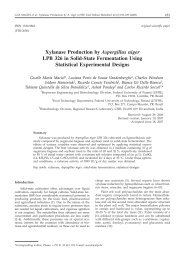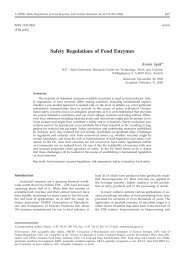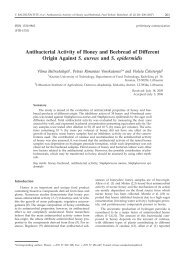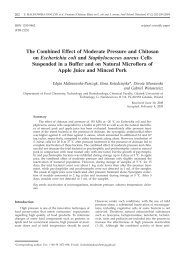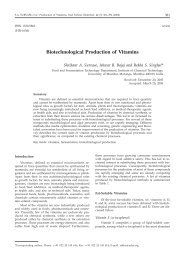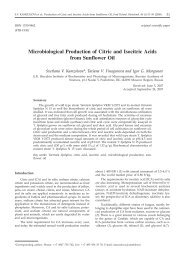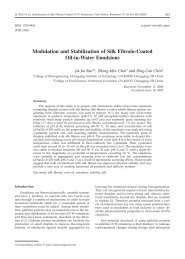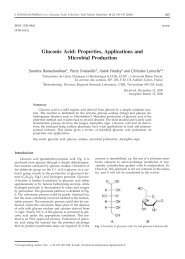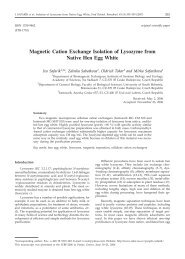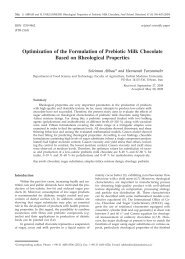A Review - Food Technology and Biotechnology
A Review - Food Technology and Biotechnology
A Review - Food Technology and Biotechnology
Create successful ePaper yourself
Turn your PDF publications into a flip-book with our unique Google optimized e-Paper software.
B. KOSIN <strong>and</strong> S.K. RAKSHIT: Criteria for Production of Probiotics, <strong>Food</strong> Technol. Biotechnol. 44 (3) 371–379 (2006)<br />
375<br />
mitogen-induced lymphocyte proliferation assay, in which<br />
enhancement or inhibition of the response was the result<br />
of the immunomodulating properties of LAB for which<br />
either T-cells or accessory cells may be sensitive.<br />
Multistrain Selection<br />
According to some authors, functionality of a multistrain/multispecies<br />
probiotics could be more effective<br />
<strong>and</strong> more consistent than that of a monostrain (63,64).<br />
Studies on the interactions among lactic acid starter <strong>and</strong><br />
probiotic bacteria have been investigated to establish<br />
adequate combinations of strains (65). A required dosage<br />
of the probiotic supplemented with normal feed should<br />
be ascertained depending on a delivery pattern <strong>and</strong> form<br />
of probiotic products when incorporated into animal feed.<br />
This review cites recent studies <strong>and</strong> methods of development<br />
of probiotics for potential functional food/feed<br />
products.<br />
Functionality of a multistrain probiotic could be<br />
more effective <strong>and</strong> more consistent than that of monostrain<br />
probiotic. Colonization of an ecosystem providing<br />
a niche for more than 400 species in combination with<br />
individually determined host-factors is anticipated to be<br />
more successful with multistrain (multispecies) of probiotics<br />
than monostrain preparations (66,67). Interaction<br />
among lactic acid starter <strong>and</strong> probiotic bacteria has been<br />
investigated to establish adequate combinations of strains<br />
to manufacture probiotic dairy products using strains of<br />
Streptococcus thermophilus, Lactobacillus delbrueckii ssp.<br />
bulgaricus, Lactococcus lactis, Lactobacillus acidophilus, Lactobacillus<br />
casei, <strong>and</strong> Bifidobacterium spp. (63). The detection<br />
of bacterial interactions was carried out using well-<br />
-diffusion agar assay, <strong>and</strong> the interactions found were<br />
further characterized by growth kinetics. The study of<br />
interactions by growth kinetics allowed the setting of<br />
four different kinds of behaviour between species of lactic<br />
acid starter <strong>and</strong> probiotic bacteria (stimulation, delay,<br />
complete inhibition of growth, <strong>and</strong> no effects among<br />
them). The possible interactions among the strains selected<br />
should be considered when choosing the best combinations<br />
in order to optimize their performance in the<br />
process <strong>and</strong> their survival in the products (65). Recently,<br />
functionality <strong>and</strong> efficacy of monostrain, multistrain <strong>and</strong><br />
multispecies probiotics have been summarized by Timmerman<br />
et al. (63). From a wide range of work trials in<br />
different hosts, multispecies probiotics were found to be<br />
superior in treating antibiotic-associated diarrhea in children,<br />
improve growth performance <strong>and</strong> particularly mortality<br />
in broilers <strong>and</strong> showed better protected mice against<br />
S. typhimurium infection. Also, multispecies probiotics provided<br />
the best clearance of E. coli O157:H7 from lambs<br />
(63). Rats challenged with S. enteritidis showed best post-<br />
-challenge mass gain when treated with multispecies<br />
probiotics. Possible mechanisms underlying the enhanced<br />
effects of probiotic mixtures are also discussed (63).<br />
It is emphasized that strains used in multistrain <strong>and</strong><br />
multispecies probiotics should be compatible <strong>and</strong> preferably<br />
synergistic. The design <strong>and</strong> use of multistrain <strong>and</strong><br />
multispecies probiotics need to be studied well before<br />
use.<br />
Application of Probiotics in Feed Processing<br />
Probiotics are incorporated into animal feed as one<br />
of specific additives (including antioxidants, binding<br />
agents, preservatives, enzymes) in different ways (e.g.<br />
during or after processing or top-dressing feed mix). In<br />
Europe this comes under strict legislation for reared species<br />
or groups of species. Maximal authorized doses <strong>and</strong><br />
conditions of use are specified. Feed manufacture involves<br />
pelleting, extrusion process <strong>and</strong> complementary<br />
processes, requires pressures <strong>and</strong> high temperatures which<br />
may affect the viability of probiotics applied in the feed.<br />
Typical feed for broiler chickens is processed at about<br />
75–85 °C for 15–20 s with a moisture content of 15 % before<br />
pelleting.<br />
In order to maintain viability <strong>and</strong> survival of probiotics<br />
during feed manufacturing, cultures (broth, dry),<br />
drying method used (spray-dry, freeze-dry), single or mixture<br />
culture (monostrain or multispecies), feed matrices<br />
(e.g. alginate beads, xanthan-gellan beads, fermented<br />
feed), synbiotic effect (prebiotics), etc. are studied (68).<br />
Composite carrier matrix systems are being developed<br />
for the purpose of protecting probiotics from the<br />
stress <strong>and</strong> heat (spray-dry) treatment. Leverrier et al.<br />
(69) investigated tolerance of probiotics to stress in digestive<br />
tract with simulated gastrointestinal juice consisting<br />
of acid <strong>and</strong> bile salt by using different food matrices<br />
(alginate beads, xanthan-gellan beads, fermented milk).<br />
Tests on viability of bacteria on spray-drying in an aqueous<br />
binary mixture composed of skim milk <strong>and</strong> polyvinylpyrrolidone<br />
(PVP K90) as encapsulation matrix have<br />
also been done (70). Boza et al. (71) reported that dehydrated<br />
glucose syrups resulted in products with the<br />
greatest percentage of survival of probiotic cells microencapsulated<br />
in it during the spray-drying, compared to<br />
other carbohydrates (maltodextrin, gum acacia <strong>and</strong> modified<br />
starch materials).<br />
In the freeze-drying method, glycerol <strong>and</strong> skim milk<br />
that act as cryoprotective agents appeared to preserve<br />
probiotic strain (72). Carvalho et al. (73) reviewed several<br />
relevant factors for the preparation <strong>and</strong> preservation<br />
of freeze-dried lactic acid bacteria, including specific effects<br />
of intrinsic factors, growth factors, sublethal treatments,<br />
drying media, storage <strong>and</strong> rehydration. Freeze-<br />
-drying, however, is a costly method for large scale<br />
production of such products.<br />
Probiotic milk-based formulations were spray-dried<br />
with various combinations of prebiotic substances in an<br />
effort to generate synbiotic powder products. The effect<br />
of growth phase <strong>and</strong> inclusion of a prebiotic substance<br />
in the feed media on probiotic viability during spray-<br />
-drying was studied. It was found that Lactobacillus rhamnosus<br />
GG, spray-dried in stationary phases of growth in<br />
reconstituted skim milk, as well as polydextrose (PD) mixture<br />
at an outlet temperature of 85–90 °C survived best<br />
(31–50 %) in both feed media <strong>and</strong> were the most stable<br />
during powder storage at 4–37 °C during 8 weeks, with<br />
30–140-fold reductions in cell viability at 37 °C in RSM<br />
<strong>and</strong> PD/RSM powders, respectively (74).



